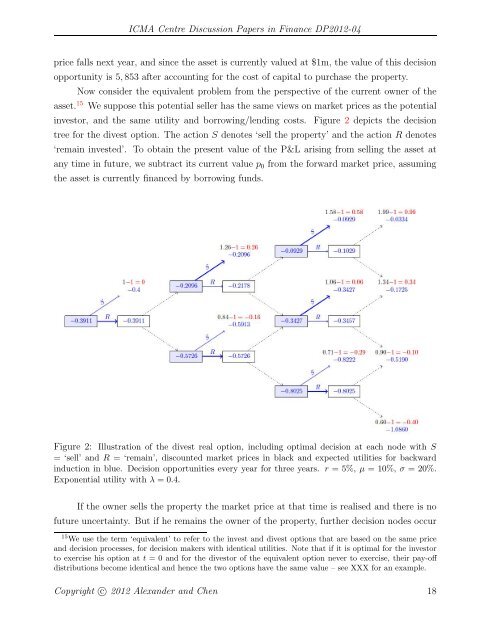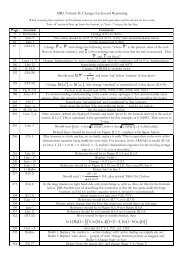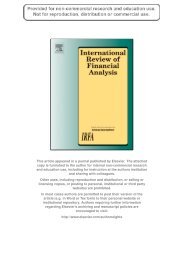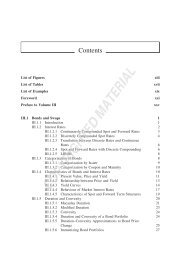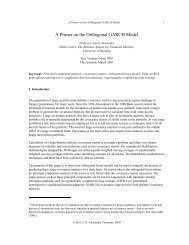<strong>ICMA</strong> <strong>Centre</strong> Discussion Papers in Finance DP2012-04price falls next year, and since the asset is currently valued at $1m, the value of this decisionopportunity is 5, 853 after accounting for the cost of capital <strong>to</strong> purchase the property.Now consider the equivalent problem from the perspective of the current owner of theasset. 15 We suppose this potential seller has the same views on market prices as the potentialinves<strong>to</strong>r, and the same utility and borrowing/lending costs. Figure 2 depicts the decisiontree for the divest option. The action S denotes ‘sell the property’ and the action R denotes‘remain invested’. To obtain the present value of the P&L arising from selling the asset atany time in future, we subtract its current value p 0 from the forward market price, assumingthe asset is currently financed by borrowing funds.Figure 2: Illustration of the divest real option, including optimal decision at each node <strong>with</strong> S= ‘sell’ and R = ‘remain’, discounted market prices in black and expected utilities for backwardinduction in blue. Decision opportunities every year for three years. r =5%,μ = 10%, σ = 20%.Exponential utility <strong>with</strong> λ =0.4.If the owner sells the property the market price at that time is realised and there is nofuture uncertainty. But if he remains the owner of the property, further decision nodes occur15 We use the term ‘equivalent’ <strong>to</strong> refer <strong>to</strong> the invest and divest options that are based on the same priceand decision processes, for decision makers <strong>with</strong> identical utilities. Note that if it is optimal for the inves<strong>to</strong>r<strong>to</strong> exercise his option at t = 0 and for the dives<strong>to</strong>r of the equivalent option never <strong>to</strong> exercise, their pay-offdistributions become identical and hence the two options have the same value – see XXX for an example.Copyright c○ 2012 Alexander and Chen 18
<strong>ICMA</strong> <strong>Centre</strong> Discussion Papers in Finance DP2012-04at future times when the market price is uncertain. If he does not sell the property at orbefore t = 2, the terminal market prices can take one of two values, given the price at thepenultimate node. For instance, if the market price moves up at t =1andatt =2,thenatt = 3 it could be either 1.99 or 1.34, <strong>with</strong> equal probability. Now the computation of expectedutilities and application of (12) and(13) proceed exactly as before. The expected utility attime 0 is −0.0321 and its CE is −0.4 log(0.0321/0.4) = 9, 030 × 10 −6 . We conclude that thisreal option <strong>to</strong> divest has value $9,030 <strong>to</strong> this particular owner, whose optimal decision is <strong>to</strong>keep the asset now but sell it if the price goes up next year.The current price p 0 plays the role of a fixed cost <strong>to</strong> the dives<strong>to</strong>r. This contrasts <strong>with</strong>the investment option, where the inves<strong>to</strong>r pays the market price of the asset at the time hechooses <strong>to</strong> invest, so his cost is not constant. As a result, when the parameters that determinethe market price are changed the pay-off distribution of the divest option fluctuates at leastas much, and often more than that of the equivalent invest option. Thus the divest optionvalue is at least as sensitive as the equivalent invest option <strong>to</strong> changes in the parameters of theprice process. We shall explore the sensitivity of real option values <strong>to</strong> changes in the decisionmaker’s subjective views about expected return and risk in Section 4.6.4.2 Investment Costs and the Risk-Neutral <strong>Valuation</strong> <strong>Approach</strong>Again consider the example of Figure 1, but now allow the investment cost <strong>to</strong> take the generalform (7) <strong>with</strong> K = $1m. We compare the case α = 0 considered above <strong>with</strong> the fixed-strikeoption where α = 1, and <strong>with</strong> the case α =0.5. The investment threshold depends cruciallyon α: whenα = 0 (invest at market price) it may become optimal <strong>to</strong> invest but only if theprice falls, as shown above. However, when α = 1 so we have a fixed strike, at-the-money(ATM) option, it may become optimal <strong>to</strong> invest but only if the price rises because in this casethe option value depends on the expected utility of an ATM call option pay-off.Table 1 shows how the option value increases <strong>with</strong> both α and the inves<strong>to</strong>r’s risk <strong>to</strong>lerance.The value of $5,853 that was derived using Figure 1 isshowninbold. Therealoption values increases <strong>with</strong> both α and λ. As λ →∞the option value converges <strong>to</strong> therisk-neutral (linear utility) value, and for the fixed-cost case α = 1 we obtain the maximumvalue of $224,333. This value is still contingent on the inves<strong>to</strong>r’s personal views about marketprices. In the case that the investment risks are perfectly hedgeable, as under the standardRNV assumptions, the option price is $108,285. The RNV price is the same for all inves<strong>to</strong>rs(independent of λ) and it can be derived in our framework using a linear utility and settingμ = r (in this case 5%).Great care should be taken when making assumptions about investment costs. In someCopyright c○ 2012 Alexander and Chen 19


